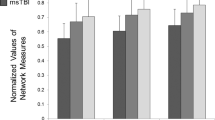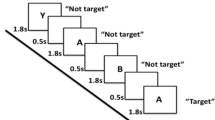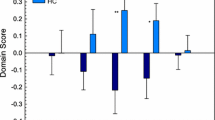Abstract
Recent research on traumatic brain injury (TBI) has shown that impairments in cognitive and executive control functions are accompanied by a disrupted neural connectivity characterized by white matter damage. We constructed binary and weighted brain structural networks in 21 patients with chronic TBI and 17 healthy young adults utilizing diffusion tensor tractography and calculated topological properties of the networks using a graph theoretical method. Executive function was assessed with the local global task and the trail making task, requiring inhibition, updating, and switching. The results revealed that TBI patients were less successful than controls on the executive tasks, as shown by the higher reaction times, higher switch costs, and lower accuracy rates. Moreover, both TBI patients and controls exhibited a small world topology in their white matter networks. More importantly, the TBI patients demonstrated increased shortest path length and decreased global efficiency of the structural network. These findings suggest that TBI patients have a weaker globally integrated structural brain network, resulting in a limited capacity to integrate information across brain regions. Furthermore, we showed that the white matter networks of both groups contained highly connected hub regions that were predominately located in the parietal cortex, frontal cortex, and basal ganglia. Finally, we showed significant correlations between switching performance and network property metrics within the TBI group. Specifically, lower scores on the switching tasks corresponded to a lower global efficiency. We conclude that analyzing the structural brain network connectivity provides new insights into understanding cognitive control changes following brain injury.





Similar content being viewed by others
Abbreviations
- DAI:
-
Diffuse axonal injury
- DTI:
-
Diffusion tensor imaging
- FA:
-
Fractional anisotropy
- LGL:
-
Local global task
- TBI:
-
Traumatic brain injury
- TMT:
-
Trail making task
- WM:
-
White matter
References
Achard S, Bullmore E (2007) Efficiency and cost of economical brain functional networks. PLoS Comput Biol 3:174–183
Adams JH, Doyle D, Ford I, Gennarelli TA, Graham DI, McLellan DR (1989) Diffuse axonal injury in head injury: definition, diagnosis and grading. Histopathology 15:49–59
Aron AR, Poldrack RA (2006) Cortical and subcortical contributions to stop signal response inhibition: role of the subthalamic nucleus. J Neurosci 26:2424–2433
Axelrod BN, Fichtenberg NL, Liethen PC, Czarnota MA, Stucky K (2001) Performance characteristics of postacute traumatic brain injury patients on the WAIS-III and WMS-III. Clinical Neuropsychologist 15:516–520
Basser PJ, Pierpaoli C (1996) Microstructural and physiological features of tissues elucidated by quantitative-diffusion-tensor MRI. J MagnReson B 111:209–219
Basser PJ, Pajevic S, Pierpaoli C, Duda J, Aldroubi A (2000) In vivo fiber tractography using DT-MRI data. Magn Reson Med 44:625–632
Bassett DS, Brown JA, Deshpande V, Carlson JM, Grafton ST (2011) Conserved and variable architecture of human white matter connectivity. Neuroimage 54:1262–1279
Bast T (2007) Toward an integrative perspective on hippocampal function: from the rapid encoding of experience to adaptive behavior. Rev Neurosci 18:253–281
Behrens TEJ, Berg HJ, Jbabdi S, Rushworth MFS, Woolrich MW (2007) Probabilistic diffusion tractography with multiple fibre orientations: what can we gain? Neuroimage 34:144–155
Behrmann M, Geng JJ, Shomstein S (2004) Parietal cortex and attention. Curr Opin Neurobiol 14:212–217
Bruns TJ, Hauser WA (2003) The epidemiology of traumatic brain injury: a review. Epilepsia 44:2–10
Bullmore E, Sporns O (2009) Complex brain networks: graph theoretical analysis of structural and functional systems. Nat Rev Neurosci 10:186–198
Caeyenberghs K, Leemans A, Geurts M, Taymans T, Vander LC, Smits-Engelsman BC et al (2010a) Brain-behavior relationships in young traumatic brain injury patients: fractional anisotropy measures are highly correlated with dynamic visuomotor tracking performance. Neuropsychologia 48:1472–1482
Caeyenberghs K, Leemans A, Geurts M, Taymans T, Linden CV, Smits-Engelsman BC et al (2010b) Brain-behavior relationships in young traumatic brain injury patients: dTI metrics are highly correlated with postural control. Hum Brain Mapp 31:992–1002
Caeyenberghs K, Leemans A, Geurts M, Linden CV, Smits-Engelsman BC, Sunaert S et al (2011) Correlations between white matter integrity and motor function in traumatic brain injury patients. Neurorehabil Neural Repair 25:492–502
Caeyenberghs K, Leemans A, Heitger MH, Leunissen I, Dhollander T, Sunaert S, Dupont P, Swinnen SP (2012) Graph analysis of functional brain networks for cognitive control of action in traumatic brain injury. Brain 135(Pt 4):1293–1307
Carrera E, Bogousslavsky J (2006) The thalamus and behavior—Effects of anatomically distinct strokes. Neurology 66:1817–1823
Cavanna AE, Trimble MR (2006) The precuneus: a review of its functional anatomy and behavioural correlates. Brain 129:564–583
Coxon JP, Goble DJ, Van IA, De VJ, Wenderoth N, Swinnen SP (2010) Reduced basal ganglia function when elderly switch between coordinated movement patterns. Cereb Cortex 20:2368–2379
Demakis GJ (2004) Frontal lobe damage and tests of executive processing: a meta-analysis of the category test, stroop test, and trail-making test. J Clin Exp Neuropsychol 26:441–450
Descoteaux M, Deriche R, Knosche TR, Anwander A (2009) Deterministic and Probabilistic Tractography Based on Complex Fibre Orientation Distributions. IEEE Trans Med Imaging 28:269–286
Draper K, Ponsford J (2008) Cognitive functioning ten years following traumatic brain injury and rehabilitation. Neuropsychology 22:618–625
Forstmann BU, Keuken MC, Jahfari S, Bazin PL, Neumann J, Schäfer A, Anwander A, Turner R (2012) Cortico-subthalamic white matter tract strength predicts interindividual efficacy in stopping a motor response. Neuroimage 60(1):370–375
Gale SD, Baxter L, Roundy N, Johnson SC (2005) Traumatic brain injury and grey matter concentration: a preliminary voxel based morphometry study. J Neurol Neurosurg Psychiatry 76:984–988
Gilbert SJ, Burgess PW (2008) Executive function. Curr Biol 18:R110–R114
Godefroy O (2003) Frontal syndrome and disorders of executive functions. J Neurol 250:1–6
Gong G, He Y, Concha L, Lebel C, Gross DW, Evans AC, Beaulieu C (2009) Mapping anatomical connectivity patterns of human cerebral cortex using in vivo diffusion tensor imaging tractography. Cereb Cortex 19:524–536
Gouveia PAR, Brucki SMD, Malheiros SMF, Bueno OFA (2007) Disorders in planning and strategy application in frontal lobe lesion patients. Brain Cogn 63:240–246
Grados MA, Slomine BS, Gerring JP, Vasa R, Bryan N, Denckla MB (2001) Depth of lesion model in children and adolescents with moderate to severe traumatic brain injury: use of SPGR MRI to predict severity and outcome. J NeurolNeurosurg Psychiatry 70:350–358
Guilmette TJ, Dabrowski J, Kennedy ML, Gnys J (1999) A comparison of nine WAIS-R short forms in individuals with mild to severe traumatic brain injury. Assessment 6:33–41
Guye M, Bettus G, Bartolomei F, Cozzone PJ (2010) Graph theoretical analysis of structural and functional connectivity MRI in normal and pathological brain networks. MAGMA 23:409–421
Hagmann P, Cammoun L, Gigandet X, Meuli R, Honey CJ, Wedeen VJ, Sporns O (2008) Mapping the structural core of human cerebral cortex. PLoS Biol 6(7):e159
Hagmann P, Cammoun L, Gigandet X, Gerhard S, Grant PE, Wedeen V et al (2010) MR connectomics: principles and challenges. J Neurosci Methods 194:34–45
Hess CP, Mukherjee P, Han ET, Xu D, Vigneron DB (2006) Q-ball reconstruction of multimodal fiber orientations using the spherical harmonic basis. MagnReson Med 56:104–117
Hester R, Foxe JJ, Molholm S, Shpaner M, Garavan H (2005) Neural mechanisms involved in error processing: a comparison of errors made with and without awareness. Neuroimage 27:602–608
Ide JS, Li CSR (2011) A cerebellar thalamic cortical circuit for error-related cognitive control. Neuroimage 54:455–464
Iturria-Medina Y, Sotero RC, Canales-Rodriguez EJ, Aleman-Gomez Y, Melie-Garcia L (2008) Studying the human brain anatomical network via diffusion-weighted MRI and Graph Theory. Neuroimage 40:1064–1076
Iturria-Medina Y, Pérez Fernández A, Morris DM, Canales-Rodríguez EJ, Haroon HA, GarcíaPentón L et al (2011) Brain hemispheric structural efficiency and interconnectivity rightward asymmetry in human and nonhuman primates. Cereb Cortex 21:56–67
Jeurissen B, Leemans A, Jones DK, Tournier JD, Sijbers J (2011) Probabilistic Fiber Tracking Using the Residual Bootstrap with Constrained Spherical Deconvolution. Hum Brain Mapp 32:461–479
Jeurissen B, Leemans A, Tournier JD, Jones DK, Sijbers J (2012) Investigating the prevalence of complex fiber configurations in white matter tissue with diffusion magnetic resonance imaging. Hum Brain Mapp. doi:10.1002/hbm.22099
Jones DK, Leemans A (2011) Diffusion tensorimaging. Methods MolBiol 711:127–144
Kennedy MR, Wozniak JR, Muetzel RL, Mueller BA, Chiou HH, Pantekoek K et al (2009) White matter and neurocognitive changes in adults with chronic traumatic brain injury. J IntNeuropsycholSoc 15:130–136
Kinnunen KM, Greenwood R, Powell JH, Leech R, Hawkins PC, Bonnelle V et al (2011) White matter damage and cognitive impairment after traumatic brain injury. Brain 134:449–463
Kraus JF, McArthur DL (1996) Epidemiologic aspects of brain injury. NeurolClin 14:435–450
Kraus MF, Susmaras T, Caughlin BP, Walker CJ, Sweeney JA, Little DM (2007) White matter integrity and cognition in chronic traumatic brain injury: a diffusion tensor imaging study. Brain 130:2508–2519
Kubat-Silman AK, Dagenbach D, Absher JR (2002) Patterns of impaired verbal, spatial, and object working memory after thalamic lesions. Brain Cogn 50:178–193
Latora V, Marchiori M (2001) Efficient behavior of small-world networks. Phys Rev Lett 87:198701
Leemans A, Jones DK (2009) The B-matrix must be rotated when correcting for subject motion in DTI data. MagnReson Med 61:1336–1349
Leemans A, Jeurissen B, Sijbers J, Jones DK (2009) ExploreDTI: a graphical toolbox for processing, analyzing, and visualizing diffusion MR data. In: 17th Annual Meeting of the International Society for Magnetic Resonance in Medicine, p 3537, Hawaii, USA
Leunissen I, Coxon JP, Geurts M, Caeyenberghs K, Michiels K, Sunaert S et al (2012) Disturbed cortico-subcortical interactions during motor task switching in traumatic brain injury. Hum Brain Mapp. doi:10.1002/hbm.21508
Levin HS (2003) Neuroplasticity following non-penetrating traumatic brain injury. Brain Inj 17:665–674
Levin H, Kraus MF (1994) The frontal lobes and traumatic brain injury. J Neuropsychiatry ClinNeurosci 6:443–454
Li YH, Liu Y, Li J, Qin W, Li KC, Yu CS et al (2009) Brain Anatomical Network and Intelligence. PLoSComputBiol 5:e1000395
Li Y, Liu B, Hou B, Qin W, Wang D, Yu C, Jiang T (2012) Less efficient information transfer in Cys-Allele carriers of DISC1: a brain network study based on diffusion MRI. Cereb Cortex 12
Little DM, Kraus MF, Joseph J, Geary EK, Susmaras T, Zhou XJ et al (2010) Thalamic integrity underlies executive dysfunction in traumatic brain injury. Neurology 74:558–564
Maas AIR, Stocchetti N, Bullock R (2008) Moderate and severe traumatic brain injury in adults. Lancet Neurology 7:728–741
McAllister TW, Sparling MB, Flashman LA, Guerin SJ, Mamourian AC, Saykin AJ (2001) Differential working memory load effects after mild traumatic brain injury. Neuroimage 14:1004–1012
Mesulam MM (1998) From sensation to cognition. Brain 121:1013–1052
Miyake A, Friedman NP, Emerson MJ, Witzki AH, Howerter A, Wager TD (2000) The unity and diversity of executive functions and their contributions to complex “frontal lobe” tasks: a latent variable analysis. Cogn Psychol 41:49–100
Mori S, van Zijl PC (2002) Fiber tracking: principles and strategies - a technical review. NMR Biomed 15:468–480
Mori S, Crain BJ, Chacko VP, van Zijl PC (1999) Three-dimensional tracking of axonal projections in the brain by magnetic resonance imaging. Ann Neurol 45:265–269
Navon D (1977) Forest before Trees-Precedence of global features in Visual-Perception. Cogn Psychol 9:353–383
Niendam TA, Laird AR, Ray KL, Dean YM, Glahn DC, Carter CS (2012) Meta-analytic evidence for a superordinate cognitive control network subserving diverse executive functions. Cogn Affect Behav Neurosci 12(2):241–268
Niogi SN, Mukherjee P, Ghajar J, Johnson C, Kolster RA, Sarkar R et al (2008a) Extent of microstructural white matter injury in postconcussive syndrome correlates with impaired cognitive reaction time: a 3T diffusion tensor imaging study of mild traumatic brain injury. Am J Neurorad 29:967–973
Niogi SN, Mukherjee P, Ghajar J, Johnson CE, Kolster R, Lee H et al (2008b) Structural dissociation of attentional control and memory in adults with and without mild traumatic brain injury. Brain 131:3209–3221
Oldfield RC (1971) The assessment and analysis of handedness: the Edinburgh inventory. Neuropsychologia 9:97–113
Patel TP, Ventre SC, Meaney DF (2012) Dynamic changes in neural circuit topology following mild mechanical injury in vitro. Ann Biomed Eng 40:23–36
Rubinov M, Sporns O (2010) Complex network measures of brain connectivity: uses and interpretations. Neuroimage 52:1059–1069
Salmond CH, Menon DK, Chatfield DA, Williams GB, Pena A, Sahakian BJ et al (2006) Diffusion tensor imaging in chronic head injury survivors: correlations with learning and memory indices. Neuroimage 29:117–124
Scheid R, Walther KR, Guthke T, Preul C, von Cramon DY (2006) Cognitive sequelae of diffuse axonal injury. Arch Neurol 63:418–424
Schmahmann JD, Weilburg JB, Sherman JC (2007) The neuropsychiatry of the cerebellum-insights from the clinic. Cerebellum 6:254–267
Sharp DJ, Bonnelle V, De Boissezon X, Beckmann CF, James SG, Patel MC et al (2010) Distinct frontal systems for response inhibition, attentional capture, and error processing. Proc Natl Acad Sci USA 107:6106–6111
Shu N, Liu Y, Li J, Li YH, Yu CS, Jiang TZ (2009) Altered anatomical network in early blindness revealed by diffusion tensor tractography. PLoS ONE 4:e7228
Sidaros A, Skimminge A, Liptrot MG, Sidaros K, Engberg AW, Herning M et al (2009) Long-term global and regional brain volume changes following severe traumatic brain injury: a longitudinal study with clinical correlates. Neuroimage 44:1–8
Sosin DM, Sniezek JE, Thurman DJ (1996) Incidence of mild and moderate brain injury in the United States, 1991. Brain Inj 10:47–54
Sporns O, Zwi JD (2004) The small world of the cerebral cortex. Neuroinformatics 2:145–162
Stoodley CJ, Schmahmann JD (2009) Functional topography in the human cerebellum: a meta-analysis of neuroimaging studies. Neuroimage 44:489–501
Stoodley CJ, Schmahmann JD (2010) Evidence for topographic organization in the cerebellum of motor control versus cognitive and affective processing. Cortex 46:831–844
Stuss DT, Bisschop SM, Alexander MP, Levine B, Katz D, Izukawa D (2001) The trail making test: a study in focal lesion patients. Psychol Assess 13:230–239
Tagliaferri F, Compagnone C, Korsic M, Servadei F, Kraus J (2006) A systematic review of brain injury epidemiology in Europe. Acta Neurochir 148:255–268
Teasdale G, Jennett B (1974) Assessment of coma and impaired consciousness. A practical scale. Lancet 2:81–84
Thurman DJ, Alverson C, Dunn KA, Guerrero J, Sniezek JE (1999) Traumatic brain injury in the United States: a public health perspective (Review). J Head Trauma Rehabil 14:602–615
Timmons SD (2012) An update on traumatic brain injuries. J NeurosurgSci 56:191–202
Tong KA, Ashwal S, Holshouser BA, Shutter LA, Herigault G, Haacke EM et al (2003) Hemorrhagic shearing lesions in children and adolescents with posttraumatic diffuse axonal injury: improved detection and initial results. Radiology 227:332–339
Tong KA, Ashwal S, Holshouser BA, Nickerson JP, Wall CJ, Shutter LA et al (2004) Diffuse axonal injury in children: clinical correlation with hemorrhagic lesions. Ann Neurol 56:36–50
Tournier JD, Mori S, Leemans A (2011) Diffusion Tensor Imaging and Beyond. MagnReson Med 65:1532–1556
Tuch DS (2004) Q-ball imaging. MagnReson Med 52:1358–1372
Tzourio-Mazoyer N, Landeau B, Papathanassiou D, Crivello F, Etard O, Delcroix N et al (2002) Automated anatomical labeling of activations in SPM using a macroscopic anatomical parcellation of the MNI MRI single-subject brain. Neuroimage 15:273–289
Vaessen MJ, Jansen JF, Vlooswijk MC, Hofman PA, Majoie HJ, Aldenkamp AP, Backes WH (2012) White matter network abnormalities are associated with cognitive decline in chronic epilepsy. Cereb Cortex 22:2139–2147
van den Heuvel MP, Mandl RC, Stam CJ, Kahn RS, Hulshoff Pol HE (2010) Aberrant frontal and temporal complex network structure in schizophrenia: a graph theoretical analysis. J Neurosci 30:15915–15926
Van der Werf YD, Witter MP, Uylings HBM, Jolles J (2000) Neuropsychology of infarctions in the thalamus: a review. Neuropsychologia 38:613–627
Wedeen VJ, Hagmann P, Tseng WY, Reese TG, Weisskoff RM (2005) Mapping complex tissue architecture with diffusion spectrum magnetic resonance imaging. MagnReson Med 54:1377–1386
Wedeen VJ, Wang RP, Schmahmann JD, Benner T, Tseng WY, Dai G, Pandya DN, Hagmann P, D’Arceuil H, de Crespigny AJ (2008) Diffusion spectrum magnetic resonance imaging (DSI) tractography of crossing fibers. Neuroimage 41:1267–1277
Wen W, Zhu W, He Y, Kochan NA, Reppermund S, Slavin MJ et al (2011) Discrete neuroanatomical networks are associated with specific cognitive abilities in old age. J Neurosci 31:1204–1212
Acknowledgments
This work was supported by a grant from the Research Programme of the Research Foundation—Flanders (FWO) (G.0482.010 and G.A114.11) and Grant P6/29 from the Interuniversity Attraction Poles program of the Belgian federal government. Caeyenberghs K. is funded by a postdoctoral fellowship of the Research Foundation—Flanders (FWO).
Conflict of interest
There are no conflicts of interest.
Author information
Authors and Affiliations
Corresponding author
Rights and permissions
About this article
Cite this article
Caeyenberghs, K., Leemans, A., Leunissen, I. et al. Altered structural networks and executive deficits in traumatic brain injury patients. Brain Struct Funct 219, 193–209 (2014). https://doi.org/10.1007/s00429-012-0494-2
Received:
Accepted:
Published:
Issue Date:
DOI: https://doi.org/10.1007/s00429-012-0494-2




